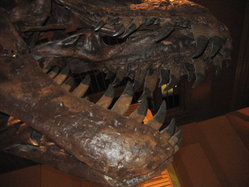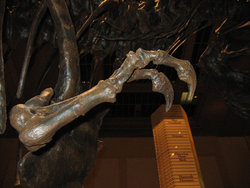Tyrannosaurus Rex 
Tyrannosaurus rex (translates as "King of Tyrannous Reptiles" or literally "tyrant lizard king"), also known colloquially as T-Rex and The King of the Dinosaurs, was a giant carnivorous theropod dinosaur from the Upper Maastrichtian, the last stage of the Cretaceous period, 65–66 million years ago. more...
Its fossil remains are relatively rare; as of 2005 only 30 specimens had been found, including three complete skulls. The first specimens found played an important role in the Bone Wars. T. rex is the best known carnivorous dinosaur, particularly because it was regarded as the largest to have ever existed for a long time. While evidence indicates that Giganotosaurus was probably larger, T. rex will very likely remain a subject of ongoing scientific research and popular culture.
Discovery and Classification
The locations of all of the discoveries are restricted to North America. The first specimen (a partial vertebra) was found by Edward Cope in 1892 and was described as Manospondylus gigas. It was assigned to Tyrannosaurus rex in 1912 by Henry Osborn. Barnum Brown, assistant curator of the American Museum of Natural History, found the second T. rex skeleton in Wyoming in 1900. This specimen was originally named Dynamosaurus imperiosus in the same paper in which Tyrannosaurus rex was described. Were it not for page order, Dynamosaurus would have become the official name. The original "Dynamosaurus" material resides in the collections of the Natural History Museum, London.
In 2000, there was a controversy regarding its name because the dinosaur bones unearthed in South Dakota in June that year may have been part of a fossil known as Manospondylus gigas. According to the rules of International Commission on Zoological Nomenclature, the system that gives animals their Latin designation, Cope's 1892 name—Manospondylus gigas—should have priority because his discovery came first. However, in the ICZN 4th edition, which took effect on 1 January 2000, Chapter 8, Article 35.5 stated that any such discovery made after 1999 does not cause the older name to replace the newer, prevailing name. Therefore, regardless of the result of the discovery, the "Tyrannosaurus rex" name is still used by biologists today.
Characteristics
Up to 50.4 feet and 20.4 feet in length and 4 tons in weight, T. rex was one of the largest carnivores of all time. Compared to other carnivorous dinosaurs, the skull of Tyrannosaurus is heavily modified. Many of the bones are fused together, preventing movement between them. The bones themselves are much more massive than is typical of a theropod, and the serrated teeth, far from being bladelike, are massive and oval in cross-section. Heavy wear and the bite marks found on bones of other dinosaurs indicate that these teeth could bite into solid bone. The teeth are often worn or broken at the tips from heavy use but, unlike mammals, were continually grown and shed throughout the life of the animal. Compared to other giant carnivorous dinosaurs such as Allosaurus, Tyrannosaurus appears to have had a sizeable brain, but was probably not particularly intelligent by mammalian standards.
The neck was short and musclular, to support the head. The arms of T. rex were very small, perhaps to make up for the weight of its enormous head, but were very sturdy. They may have been used for grasping during sex or as aids in standing. The legs were relatively long and slender for an animal of its size. To compensate for its immense bulk, the interior of many bones were hollow. This considerably reduced the weight of the skeleton while maintaining much of the strength of the bones.
Biology
As with all dinosaurs, much of Tyrannosaurus' biology—its lifespan, breeding strategy, coloration, ecology and physiology—remains unknown. A site in Alberta has at least nine Albertosaurus sarcophagus (a closely related animal) individuals of different ages preserved together, but whether these animals lived together or simply died together is unclear.
Feathers
It has been proposed that T. rex and other theropod dinosaurs may have had feathers. Small coelurosaurs (a closely related dinosaur group) from the Yixian Formation in Liaoning, China, have been discovered with either pennaceous feathers or fur-like "protofeathers", which suggest the possibility that tyrannosaurids may also have borne feathers as well. In 2004, the primitive tyrannosaurid Dilong paradoxus was discovered from the same formation with preserved long tail plumes. However, skin impressions from adult tyrannosaurs in Alberta and Mongolia appear to show the pebbly scales typical of other dinosaurs.
Evidence for Scavenging
Most debate about T. rex centers on its feeding patterns and locomotion. One scientist, noted hadrosaur expert Jack Horner, claims that T. rex was exclusively a scavenger, and did not engage in active hunting at all. Horner has only presented this in an official scientific context once, mainly discussing it in his books and in the media. His hypothesis is based on the following: T. rex have large (relative to their brain size) olfactory bulbs and olfactory nerves. These suggest a highly developed sense of smell, allegedly used to sniff out carcasses over great distances, like modern vultures. Their teeth could crack bone; a skill perhaps needed most when last to a kill and in need of extracting as much food (marrow) as possible from a carcass's least nutritious parts. Since at least some T. rex prey animals could move quickly, evidence that T. rex walked instead of ran could indicate that it was a scavenger (see more on this below). All scientists who have published on the subject since insist that T. rex was both a predator and a scavenger, taking whatever meat it could get depending on the opportunity it was presented with.
Read more at Wikipedia.org




